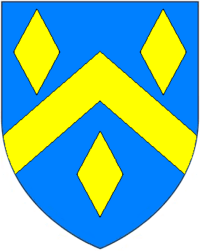Lawrence Hyde (died 1590) facts for kids
Lawrence Hyde I (who passed away in 1590) was an important person who started the famous Hyde family in Wiltshire, England. He was a Member of Parliament (MP), which means he was elected to help make laws for the country. He was also the great-great-grandfather of two British queens: Queen Mary II and Queen Anne.
Contents
Lawrence Hyde I: His Family Background
Lawrence Hyde I was the son of Robert Hyde from Norbury, Cheshire. His mother was Katherine Boydell, who was Robert's second or third wife. She came from a family named Boydell in Pulcroft, Cheshire.
Lawrence Hyde's Important Jobs
Lawrence Hyde had many important jobs during his life.
Working for the King
During the time of King Henry VIII, Lawrence worked in the King's financial office, called the Exchequer. He was a clerk, which meant he handled important paperwork and accounts.
Helping in Wiltshire
He first started working in Wiltshire for a powerful person named Sir John Thynne of Longleat. After King Henry VIII closed down many monasteries (religious buildings) in England, Lawrence helped survey and close down other religious places called chantries in Wiltshire and Salisbury in 1548.
Other Key Roles
Before 1552, he became an auditor for Edward Seymour, 1st Earl of Hertford. An auditor checks financial records to make sure everything is correct. Edward Seymour was the uncle of King Edward VI. Later, after 1575, Lawrence was in charge of surveying (checking and managing) lands owned by the Crown (the King or Queen) in Somerset. Around 1589, he also served as a Justice of the Peace (JP) in Dorset or Wiltshire. A JP helps keep law and order in a local area.
Serving as an MP
Lawrence Hyde was elected as a Member of Parliament several times:
- He became an MP for Malmesbury in 1559.
- He was elected for Heytesbury in 1584.
- He might have also been an MP for Chippenham in 1586, but this could be confused with his son, Lawrence II.
How Lawrence Hyde Gained Land
Because of his many important jobs, Lawrence Hyde was able to buy a lot of land. Much of this land became available after the King closed down the monasteries.
Key Land Purchases
In 1549, he spent about £1,250 to buy lands in places like Bymerton and Milton, a house in Salisbury, and other properties in Wiltshire. He also bought smaller properties in Somerset, Derbyshire, and Kent.
Some of his most important land purchases included:
- Dinton, Wiltshire: He bought the church lands (called the rectory) and the right to choose the priest (called the advowson) in 1585. His eldest son, Robert I Hyde, later sold these to his brother, Sir Lawrence II Hyde, in 1594. Lawrence II became the Attorney-general for Queen Anne of Denmark, who was King James I's wife.
- West Hatch: He acquired this land around 1570.
- Tisbury: He also acquired this land around 1570.
- Gussage St. Michael: He bought this during the time of King Edward VI (between 1547 and 1553).
- Wardour Castle, Wiltshire: He held the lease (a temporary right to use) for this castle for a short time before 1569, through his wife.
Lawrence Hyde's Marriages and Children
Lawrence Hyde was married two times.
First Marriage
His first wife was Mary Hartgill. She was the daughter of William Hartgill from Kilmington, Wiltshire. They had one son, but he passed away before Lawrence did.
Second Marriage and Family
Around 1559, Lawrence married Anne Sibell. She was the daughter of Nicholas Sibell from Farningham, Kent. Anne was also the widow of Matthew Colthurst, who was an MP and owned Wardour Castle. Anne brought a "fair fortune" with her, which means she had a good inheritance from her first husband. This inheritance included a lot of land in Wiltshire.
Lawrence and Anne had several children, including at least two daughters and the following sons:
- Robert Hyde: He was their eldest son and inherited Lawrence's property.
- Henry Hyde (born around 1563, died 1634): He also became an MP. Henry was the father of Edward Hyde, 1st Earl of Clarendon (1609–1674), who became a very important statesman.
- Sir Lawrence Hyde (1562–1641): He became the Attorney-general for Queen Anne of Denmark, King James I's wife.
- Sir Nicholas Hyde (born around 1572, died 1631): He became the Lord Chief Justice of England, which is a very high legal position.
Death and Burial
Lawrence Hyde I passed away on June 7, 1590. He was buried in Tisbury, where a monument (a special stone or structure) still stands. This monument mentions his son Henry, who was the father of Lord Clarendon.


